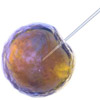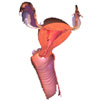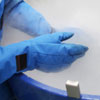- In vitro fertilisation (IVF)
- Ovarian stimulation and hyperstimulation
- Oocyte retrieval
- Intracytoplasmic sperm injection (ICSI)
- Intrauterine insemination (IUI)
- Cryopreservation
In vitro fertilisation (IVF)
 |
In vitro fertilisation (IVF) refers to the process of conceiving an embryo in a test tube. Embryos are conceived in vitro when viable male sperm and female eggs are combined in a test tube or watch glass, in a substance with similar characteristics to the inside of a woman’s uterus. |
For more information, see In Vitro Fertilisation (IVF).
Ovarian stimulation and hyperstimulation
 |
Ovarian stimulation is the process of inducing ovarian follicular development and oocyte maturation using medications. Stimulation can be used to induce a normal menstrual cycle in an anovulatory woman, or to induce ovarian hyperstimulation so that several ovarian follicles develop simultaneously and release multiple mature oocytes. |
For more information, see Ovarian Stimulation and Hyperstimulation.
Oocyte retrieval
 |
Oocyte retrieval is the process of collecting mature eggs directly from a woman’s ovaries before their release from ovarian follicles. It can be performed either to collect a single egg released as part of a woman’s natural menstrual cycle, or, most often, in conjunction with hyperovulation to enable the simultaneous retrieval of numerous mature oocytes. |
For more information, see Oocyte Retrieval.
Intracytoplasmic sperm injection (ICSI)
 |
Intracytoplasmic sperm injection (ICSI) is a micromanipulation technique used in the process of in vitro fertilisation (IVF). It involves injecting a single sperm into the centre of a mature oocyte under a microscope (i.e. injecting the sperm through the egg’s shell so that the sperm does not need to penetrate the shell in order to fertilise the egg). |
For more information, see Intracytomplasmic Sperm Injection (ICSI).
Intrauterine insemination (IUI)
 |
Intrauterine insemination (IUI) is the process of injecting sperm directly into a woman’s uterus using a catheter, to assist conception in an infertile couple. IUI increases the chances of conception in cases where fertility is underpinned by immotile or morphologically abnormal sperm, as it places the sperm closer to the vicinity of the egg and reduces the distance which sperm need to travel to come into contact with an egg. |
For more information, see Intrauterine Insemination (IUI).
Cryopreservation
 |
With relation to assisted human reproduction, cryopreservation refers to the process of freezing human gametes, embryos and/or ovarian or testicular tissues, with a view to thawing the cells for use in assisted reproduction treatments. Cryopreservation plays an important role as it enables the reproductive cells collected and/or fertilised in one treatment cycle, to be used for fertilisation and/or implantation into the female patient’s uterus, in a future treatment cycle. |
For more information, see Cryopreservation.
More information
 |
For more information on infertility, including investigations and treatments, as well as some useful animations, see Infertility. |
All content and media on the HealthEngine Blog is created and published online for informational purposes only. It is not intended to be a substitute for professional medical advice and should not be relied on as health or personal advice. Always seek the guidance of your doctor or other qualified health professional with any questions you may have regarding your health or a medical condition. Never disregard the advice of a medical professional, or delay in seeking it because of something you have read on this Website. If you think you may have a medical emergency, call your doctor, go to the nearest hospital emergency department, or call the emergency services immediately.







